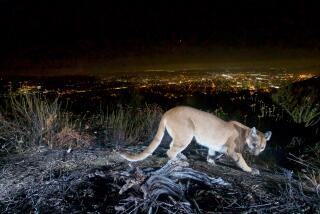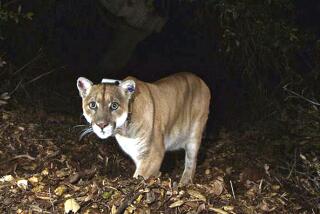After a nuisance mountain lion is killed, two L.A. city leaders want to end the practice
Two Los Angeles City Council members are pushing to end the permitted killing of mountain lions after one of the big cats was put down in the Santa Monica Mountains last month.
Along with seeking to halt depredation permits, which allow lethal action against cougars, Councilmen Paul Koretz and David Ryu announced Tuesday they were asking that the city support listing Southern California and Central Coast mountain lions as threatened under the California Endangered Species Act. The city leaders also want to establish a fund to reimburse anyone whose pets or livestock are killed by the animals.
Although the state allows landowners to take lethal action against a big cat that has killed or injured other animals if deterrents have failed, both men said mountain lions already faced an uncertain future because of significant threats, including overbuilding, destruction of wildlife corridors and exposure to rat poison.
P-56 was killed in late January under a law that allows a landowner to take lethal action against a mountain lion that has killed livestock or pets.
âThere continues to be an insane disconnect between the important conservation work we are doing in a time when we are racing the clock to protect our native species and habitat,â Koretz said in a statement.
The California Department of Fish and Wildlife, he added, âis undermining our work by handing out depredation permits on an apex predator just trying to survive in his natural habitat. We can do better and we must.â
Ryu called mountain lions âthe symbol of L.A.âs wildlifeâ but said they were at risk of extinction in the Santa Monica and Santa Ana mountains.
âItâs on us to end depredation and to protect this iconic species today, not just for Southern California mountain lions, but for the Los Angeles wild we know and love,â he said in a statement.
The future is looking increasingly bleak for some Southern California mountain lions.
Koretz and Ryu unveiled their proposed resolution â which will first go to the councilâs Rules, Elections and Intergovernmental Relations Committee â the day after authorities announced that a 4- or 5-year-old male mountain lion known as P-56 had been killed near Camarillo in late January.
A property owner in the area had reported nine attacks over two years that resulted in the loss of 12 animals, mostly sheep and lambs, despite efforts to secure the property, according to Fish and Wildlife.
Mountain lions are not listed as threatened or endangered in California, although they are classified as a âspecially protectedâ species â meaning it is illegal to kill them âunless for protection of life, livestock or other property,â said Tim Daly, an information officer with Fish and Wildlife. Mountain lion hunting has been banned in the state since 1990.
Property owners can request a depredation permit, but before the state agency will consider granting one, residents must demonstrate theyâve done all they can to protect their land and animals and discourage a predatorâs return, Daly said.
In the Santa Monica and Santa Ana mountains, landowners also must allow for a âthree-strikeâ policy before taking lethal action.
âWe donât like taking animals out of their existence, but there are times when, whether itâs a mountain lion in Southern California or a bear in Northern California, sometimes they keep pushing and pushing, and the messages to discourage their visits are no longer working,â Daly said earlier this week.
From 2015 to 2018, Fish and Wildlife issued 1,010 mountain lion depredation permits statewide, and 423 animals were killed, agency figures show. P-56 was the first collared mountain lion killed in the Santa Monicas under the state law, which was created in 2014.
The slain cougar had been monitored by the National Park Service since 2017 and was living south of the 101 Freeway in the western area of the Santa Monica Mountains. Mountain lions in that range have been part of a nearly 18-year national park study, though an unknown number of uncollared cougars live in the area as well. Daly said 4,000 to 6,000 mountain lions call California home.
For humans, Southern Californiaâs freeways link distant communities that are otherwise separated by rugged mountains, vast deserts and inland valleys.
While typically associated with the rugged terrain that gives them their name, some mountain lions have been known to venture into residential areas bordering their habitat.
Last weekend, Fish and Wildlife captured and relocated a female lion that was seen in a tree in a Simi Valley backyard. That followed several other encounters in the area since December, during which officials and residents said mountain lions attacked two dogs, killing one; mauled at least three goats; and killed several chickens in a backyard coop.
The California Department of Fish and Wildlife tracked the roughly 90-pound cat after it was seen Saturday in a backyard tree and tranquilized the animal before moving it.
Yet another mountain lion was spotted in the 5000 block of Leeds Street on Tuesday evening, according to the Simi Valley Police Department. Residents are advised to keep their distance and call authorities at (805) 583-6950 if they see the animal.
Times staff writer Colleen Shalby contributed to this report.
More to Read
Sign up for Essential California
The most important California stories and recommendations in your inbox every morning.
You may occasionally receive promotional content from the Los Angeles Times.











